We have a bit of a love affair with Orient GMTs over here at Two Broke Watch Snobs – as you can tell from our Affordable GMT Podcast Episode as well as our the previous Orient Star GMT WZ001DJ Review. So when I had the opportunity to spend time with The Orient Polaris GMT DJ05003W I only had one thing to say: “Don’t threaten me with a good time!”
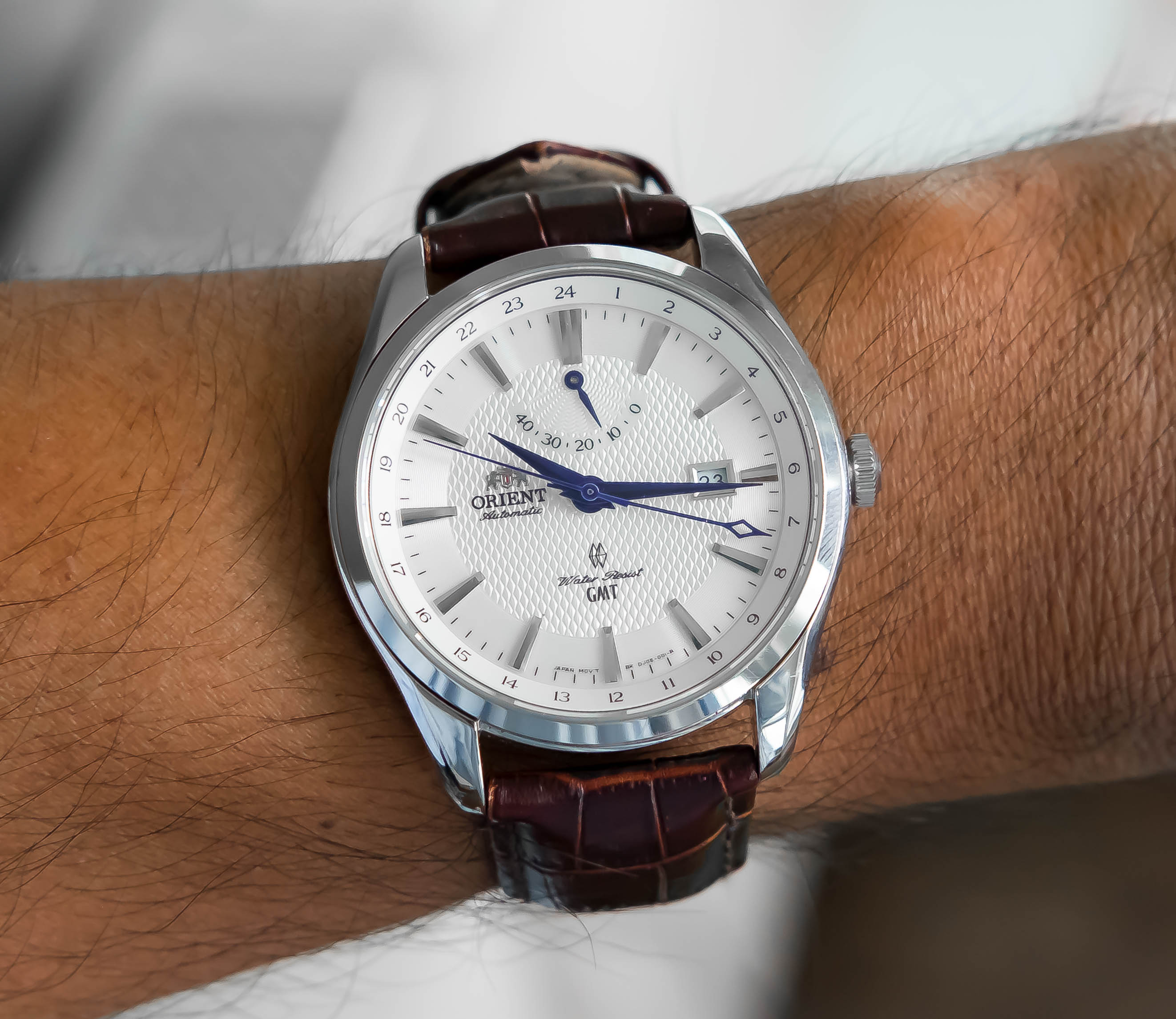
A week later the watch was on my doorstep and I was able to finally set eyes on it in person. I was inspecting the dial and the case construction – as well as testing how well the movement wound. It wasn’t about until I was 20 minutes into my inspection that I remembered something important: the Orient Polaris is a GMT watch. Out of the packaging I didn’t even notice it had a GMT hand, which is odd since traditionally the GMT hand is what people rave about and focus on with other dual time Watches.
But here with the Polaris, it’s obviously not the most forward-facing element. That’s not to say there are any legibility issues, it just made me realize two things: (1) dollar-for-dollar the Polaris is one of the most affordable mechanical GMTs out there and (2) it’s designed in such a way that it really stands apart from most other GMTs. But does all that really make the watch worth buying? Is it really even worth your consideration if you’re in the market for an affordable GMT? Let’s find out.
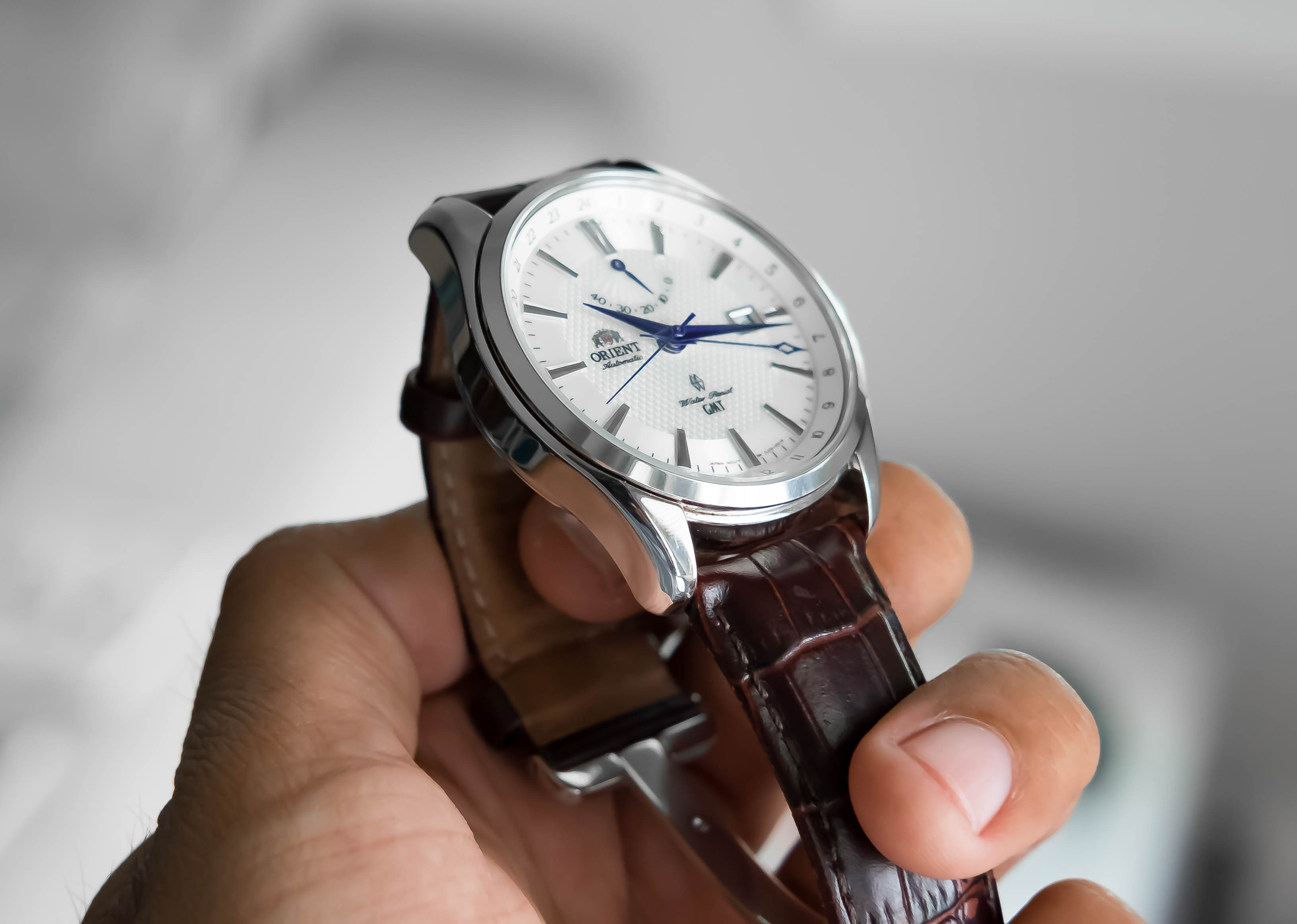
The Case:
I think people don’t necessarily realize how big these Orient GMTs can be. We saw it with the WZ0071DJ and we’re also seeing it here with the Orient Polaris. However the Polaris’ case is much more finessed and wearable than the WZ0071DJ. The reasoning behind this comes from what I believe to be one of the piece’s most unique GMT qualities; it’s a dress watch.
This isn’t quite normal or typical in what we’d see from traditional GMTs – they tend to be more utilitarian and functional. But as we’ll see in the other elements, the Polaris doesn’t want to cause confusion or try and ride the line between: it’s a dress watch first and a GMT second.
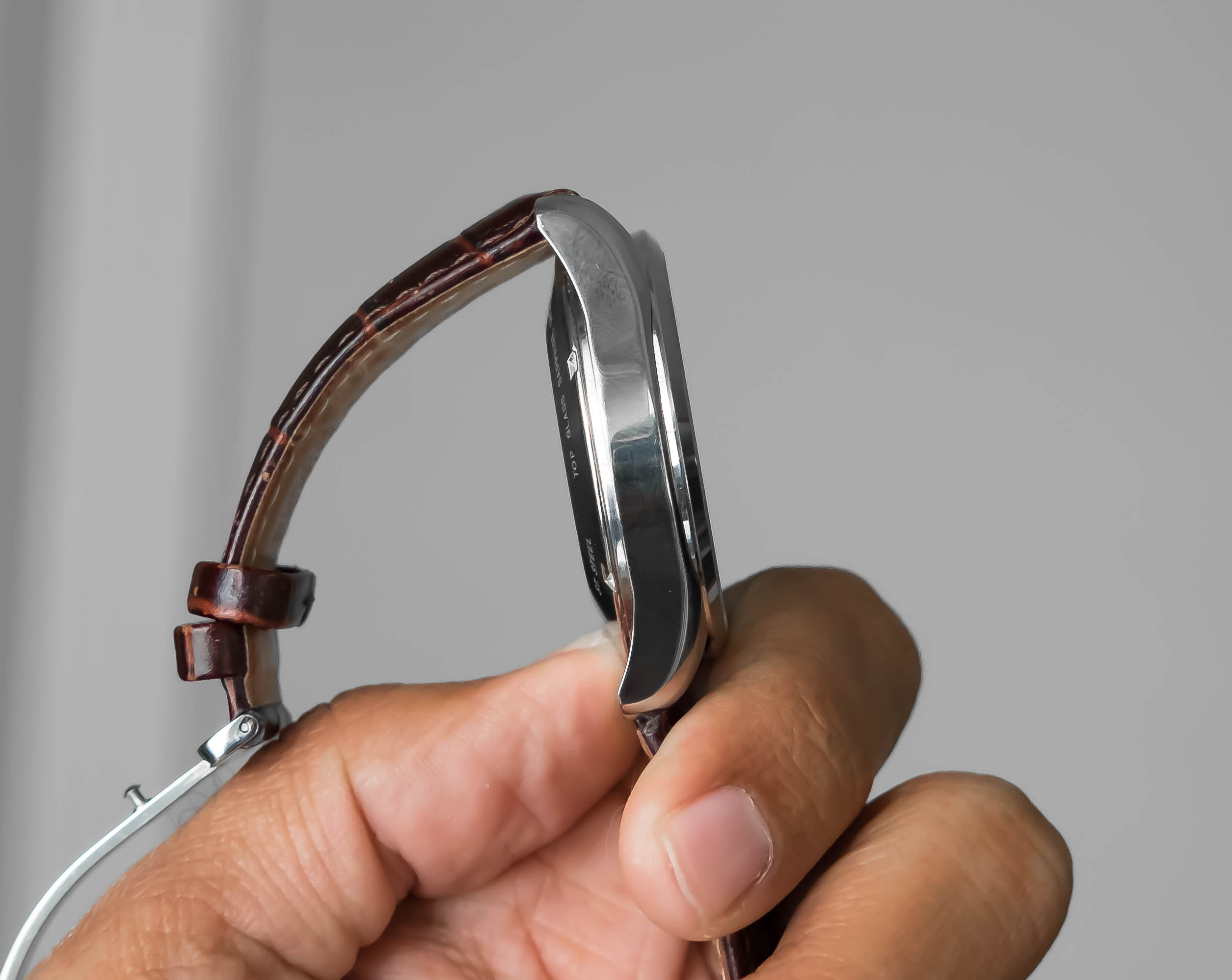
At 42mm in case diameter and 48mm lug to lug, the Polaris GMT has really solid wrist presence. However instead of possibly wearing on the thicker side, the watch measures in at approximately 11.9mm thick – super wearable! It should easily fit under a shirt sleeve/cuff if that’s a concern of yours, but shirt cuff circumference is one of those mystifying facets of men’s fashion that are as much a mystery to me as where sausages comes from.
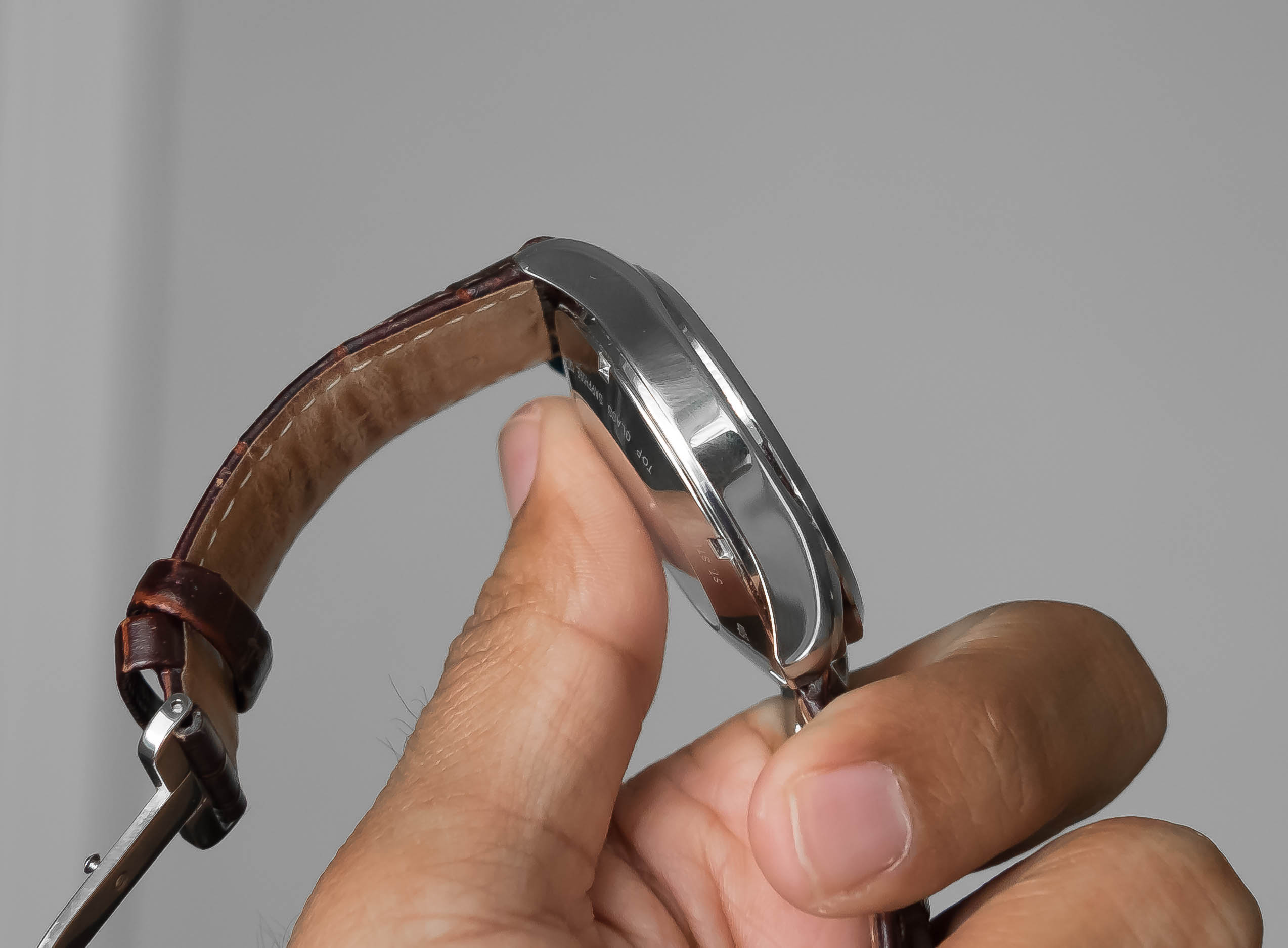
The case shape itself is quite classic and subtle, which is great because this classic take allows the dial to shine (more on the dial to come…). The lugs have a slight curvature to them for wrist-wearability. The fixed bezel has a beveled angle to it – and it’s also slightly inset into the case as opposed to butting up right against it. The design cue is a nice touch and adds an interesting visual *flow* to the case.
Further nudging the Polaris GMT into the dress watch category is the fact that the entire watch is polished quite well – they’re no brushed surfaces on the watch. What I think is done really well with the case polishing is the fact that it’s not uber reflective, which is a faux pas that many dress watches commit. It can often make the watch feel a bit chintzy or too flashy when you can basically see a 1:1 reflection off the case. That’s luckily not the case with the Orient Polaris.
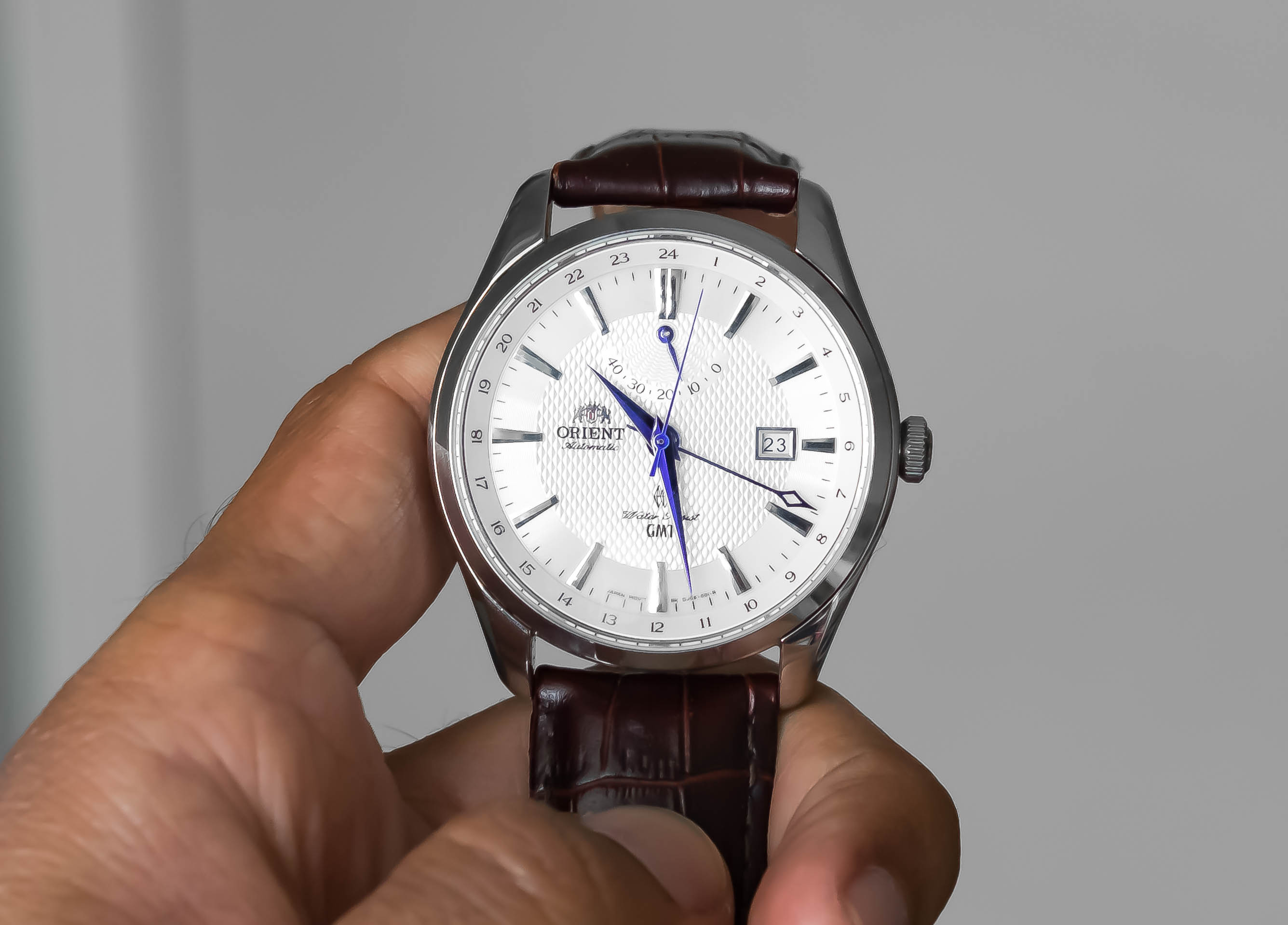
The Dial:
The dial is where all the action’s at on this GMT. The outer most perimeter of the dial is where the Orient Polaris displays its 24-Hour GMT chapter ring. It’s slightly beveled and features a really clean appearance. Just a step down from there we find the hour and minute indicators. Much like the GMT chapter ring above, the minute ticks are very simple and clean.
However the hour markers are quite striking but still subtle. They’re polished and they catch the light in a way that creates great legibility. In addition, their wedge shape helps direct your eye towards the center of the Orient Polaris’ dial. It’s also hard to see it at first, but the area behind the minute and hour indicators features a very fine concentric circle detailing/texture (a bit like a vinyl record).
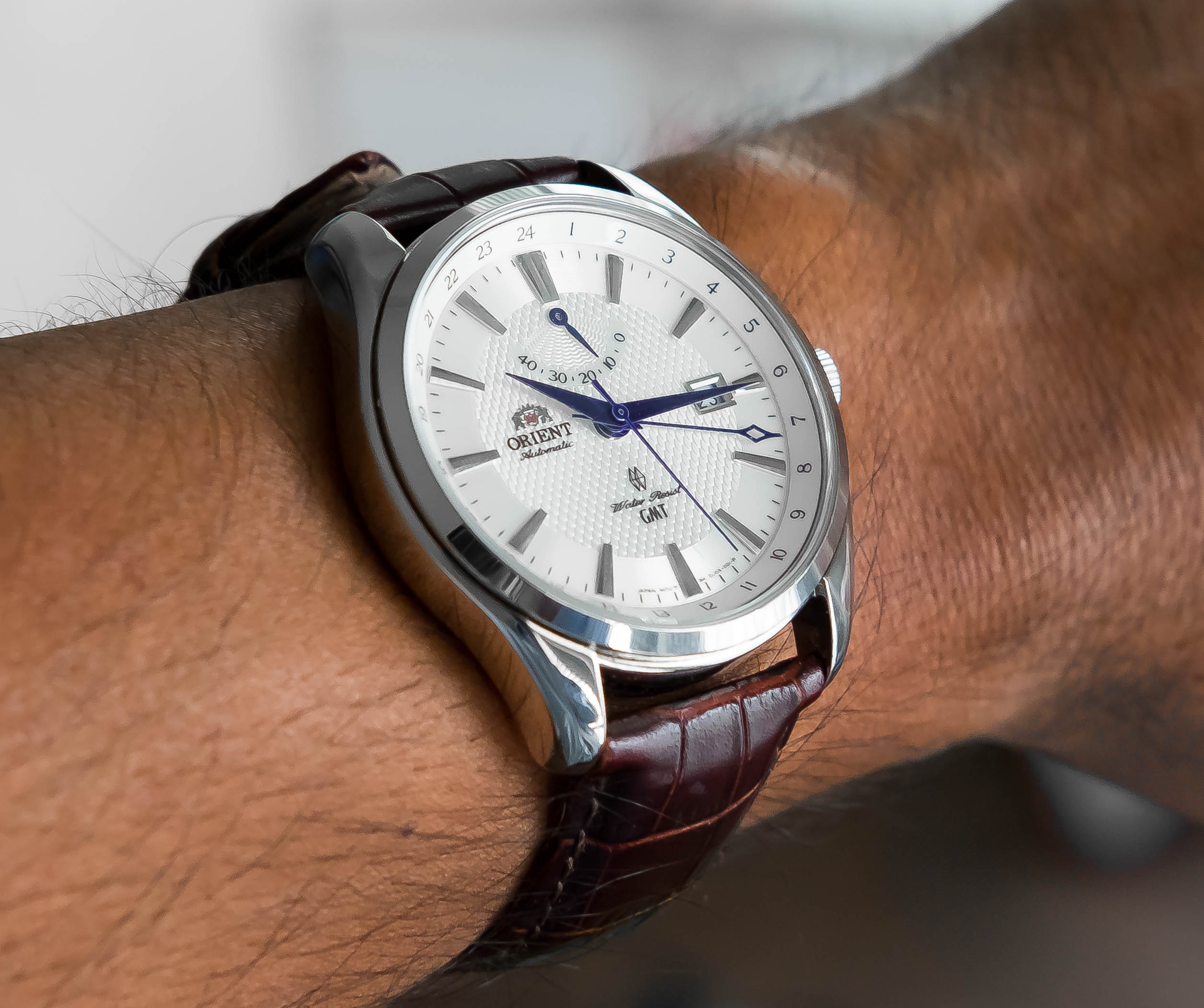
Moving a bit closer to the center yields even more impressive features. The first thing that stands out is this really incredible guilloché detailing, which is pretty uncommon in a watch as affordable as this Orient. In fact, there’s two types of guilloché here. The greater part of the dial’s interior features a uniform, repeating guilloché pattern that almost resembles woven fabric.
The second guilloché feature is on the very cool power reserve. Here the texture is concentric is contrast to the other uniform pattern. The power reserve also features the same font as the chapter ring, which helps to tie in all the Orient GMT Polaris’ visual features.
Directly to the left of the power reserve we find the Orient Polaris’ branding. It looks like the “Orient Automatic” portion is printed on the dial while the actual Orient Watch logo is applied. Moving further down the dial now to the 6 o’clock position we find a logo that I honestly haven’t seen on any other watch except the Orient Polaris GMT (if anyone has info on that please let me know in the comments below!). Also occupying this space is the text for “Water Resist” and “GMT.”
Moving up now to the 3 o’clock position is the date window. I love this date window because it’s really well balanced in my opinion. It’s not like someone randomly punch a date window on the dial and called it a day. The Orient Polaris’ date window is wrapped in the same polished material that the markers are made of, which helps to really keep the GMT watch grounded while supporting all this visual balance going on.
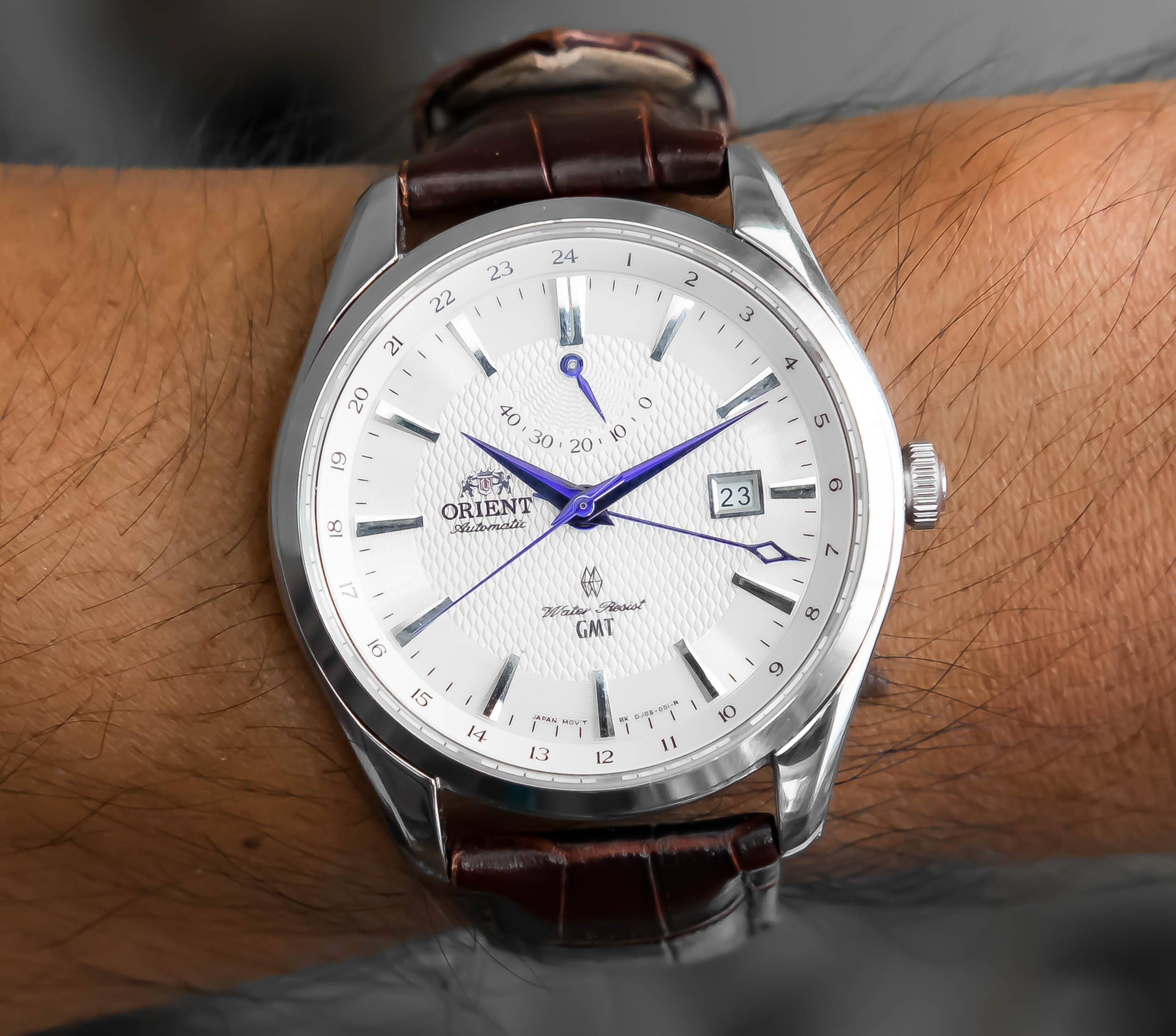
The Hands:
The hands are an interesting point of departure between the #watchfam, so dear reader I’d be interested in hearing your thoughts below on the matter. First off – they’re blue. Like, super blue – especially in contrast to the beautiful pearl and white sheen behind them. The interesting thing to note here is that it’s clear Orient wanted the Polaris GMT to look like dress watches that had blue steel hands.
The only issue is that traditionally blue steel hands (and screws) attain their characteristic blue hue from a heat source. This causes a chemical reaction in the material that turns the metal blue. The process is honestly complicated and time-consuming, and one can achieve different hues of blue from differences in techniques and such. So that’s why we often see brands cut corners or try to go for a more time-conscious process.
I believe that’s what we’re seeing here on the Orient Polaris GMT. The specific blue hue of these hands is very deep and quite uniform, but it doesn’t look quite like traditional thermal blue watch hands. It’s possible they’re chemical dyed. The watch has 5 hands (hour, minute, GMT, second sweep, and power reserve) and all of them feature this blue color.
Some people aren’t quite attracted to this feature – and some are totally into it. Me, personally? I think it totally works. Regardless of the fact that the hands most likely aren’t thermal blue, within the specific subjective design of this watch, the blue hands works simply because of how nicely they contrast against the dial.
The style of hands are very classic – except the GMT hand. This is also where the Orient Polaris again shows its odd position as a dressy GMT. Traditionally GMT hand styles are utilitarian and functional, presenting something that’s clear and legible (usually it’s just a big, straight-angled pointer triangle). But here on the Polaris it’s stylized.
The pointer triangle is still preserved but instead of hard right angles we have slightly exaggerated curves – almost like a spear tip; in a sense it feels like a more subdued version of the GMT hand on the Hamilton Jazzmaster GMT.
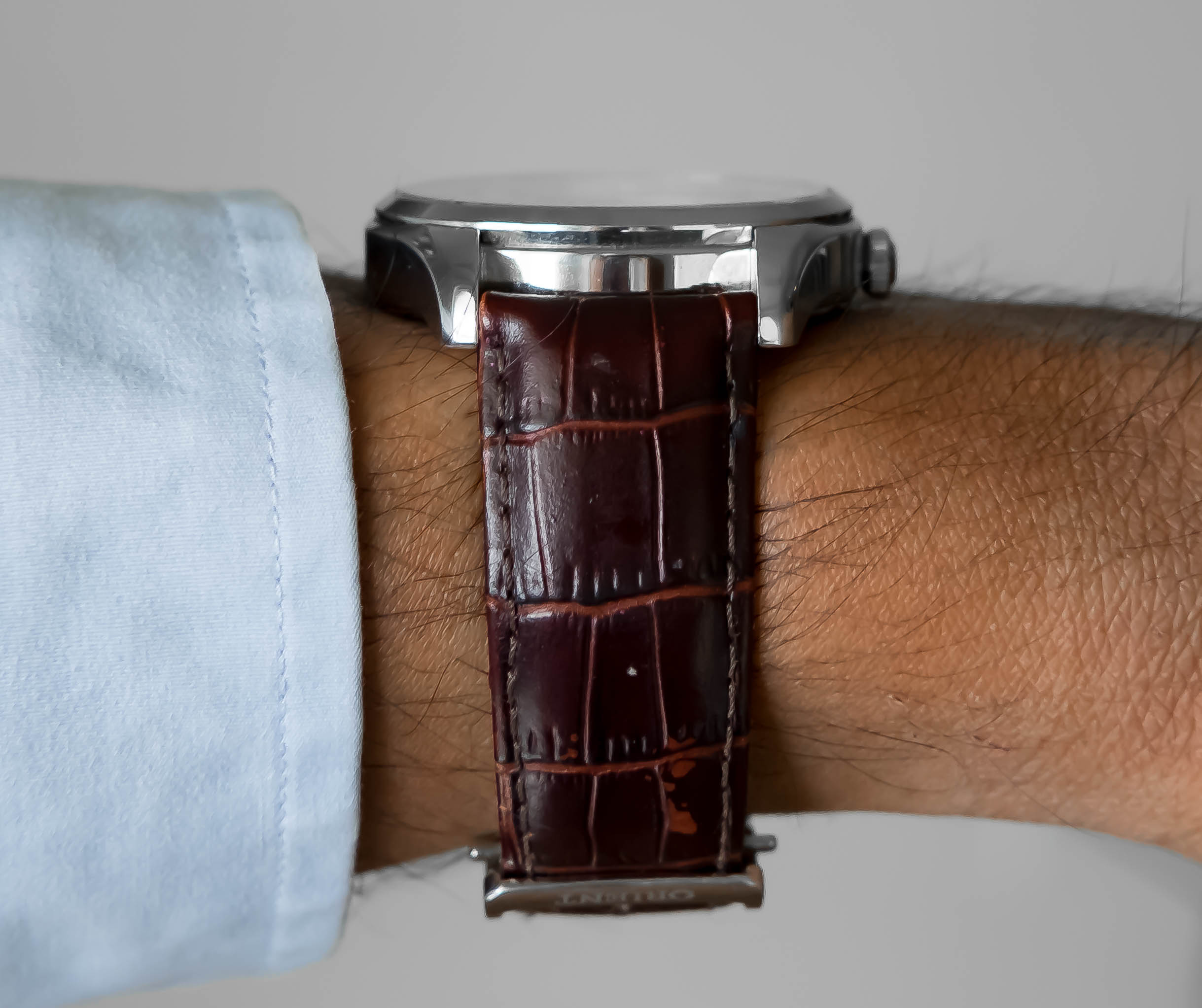
The Strap:
Strap’s bad, guys. Real bad.
But honestly, this is something we’ve talked about before we Orient. Straps and bracelets can often be a huge financial drain to do “well.” So often Orient will offer a really incredible timepiece with an in-house movement and all that jazz, but then they’ll throw it on some dog leather. But if the choice is to have an incredible watch be [$Y] amount on a crummy strap or [$y] x 2 for a good strap, I’d rather pay less and just throw my own strap on there.
The stock Polaris Strap is made of a leather material and features a faux-type of crocodile texture. But the quality obviously isn’t quite there and I can already notice some of the material chipping/wearing away in the piece I’m reviewing. It also features a deployant style clasp, which I’m honestly not a fan of.
But I will admit that the deployant itself seems to be of passable-quality (“Passable-Quality” being my old high-school nickname…). But the long and short of it is that you’ll need to most likely source some straps of your own if you buy the Orient Polaris.
The lug width is approximately 22mm, which is a welcome relief. Other Orient watch models (especially of the JDM variety) tend to be odd lug widths like 19mm or 21mm, which can make finding straps a bit tough. But with the Orient Polaris GMT at 22mm, you should have no issue.
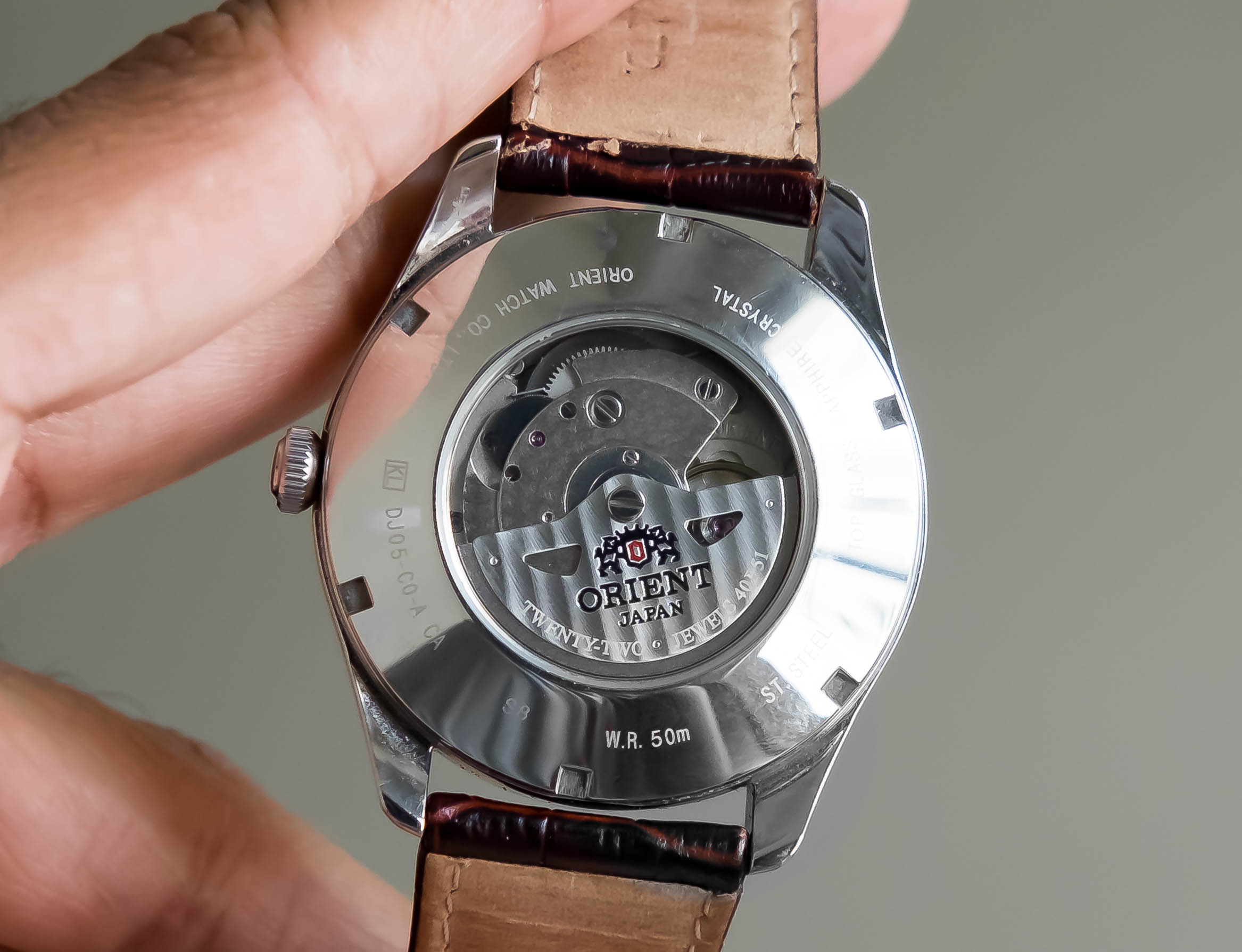
The Movement:
The watch is powered by the Orient 40P51, an in-house caliber that hacks, hand winds, and features an automatic rotor. All in all it’s a solid movement that’s quite identical to the 40P53 found in the Orient Star WZ0071DJ. Orient caliber designations can be interesting in that they tend to vary only slightly from model to model. Visually, the main difference between the 40P51 in the Polaris and the Orient Star’s 40P53 is the rotor.
The 40P53 features the OS branding as well as some slightly more refined detailing. The rotor on the 40P51 features the standard Orient Logo, but the quality and detail aren’t quite what we see on some more expensive OS models. The 40P51/3 are distinguished specifically by the power reserve and independently set GMT hand.
Final Thoughts:
The GMT tends to be a bit of an anomaly in the #watchfam. Where the dive watch has been ironically welcomed into the arms of the modern “Desk Diver,” the GMT watch still seems positioned in the mind of the watch collector as a tool. I’ve had plenty of conversations with people who’ve said something along the lines of “Oh, man – yea. [xyz] GMT watch is awesome. But I have no reason to buy a GMT.”
Dude, who the hell needs a reason to buy a GMT watch?? I didn’t buy my Seiko Sumo because I needed a robust tool to study the intricate mating rituals of the Madagascan albino narwhal – I needed a watch for a Disney cruise so I didn’t feel bad about dripping free ice-cream on my SNK (+ points for “Ice-Cream Resistance” testing – COSC, I’m looking at you).
Due to this odd clinging predilection of the GMT watch as functional piece – the ideal GMT tends to look like a tool watch in people’s minds – utilitarian, no frills, super legible, sometimes with country capitals all over the chapter ring. But the reality these days is that watch collecting for the majority of people is a niche novelty, and we don’t really need a reason to want a specific type of watch.
That’s why the Orient Polaris GMT is especially noteworthy to me – the dang thing is obviously a dress watch that happens to have a GMT complication. So we can interpret this in two ways (1) this is Orient’s response to the need for a clean, modern GMT watch for a jet-setting business person or (2) Orient understood that people just want a cool affordable GMT watch… hell, maybe both options are correct.
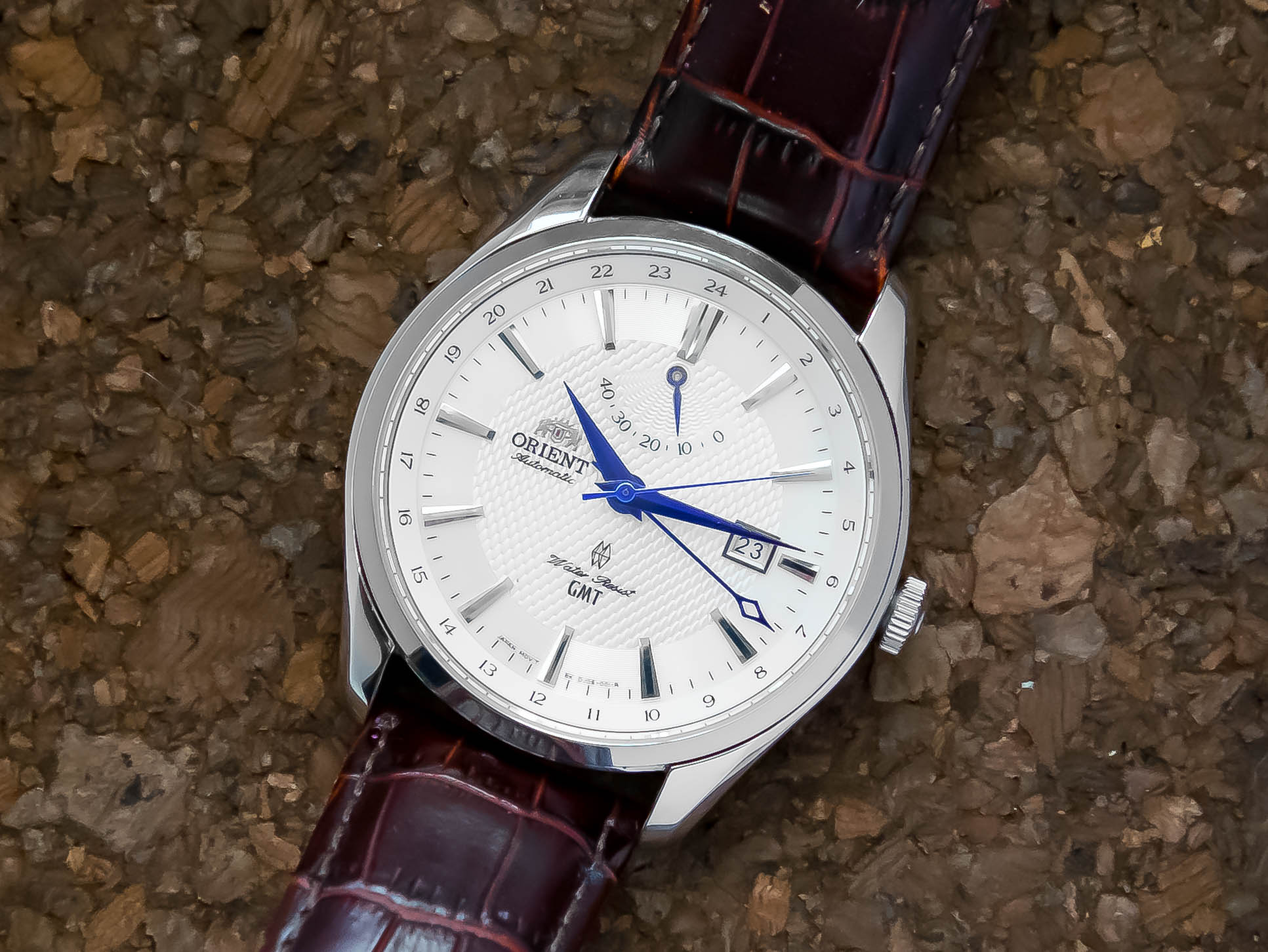
Regardless, the Orient Polaris is an incredible modern GMT that honestly would be welcome in any watch collector’s box. Is it the best affordable GMT? That’s honestly speculative and relative, but I can definitely say that this watch will give any other affordable GMT under $1000 a serious run for it’s money. It features an in-house movement, sapphire crystal, beautiful dial guilloché detailing, and a lot more.
The Orient Polaris GMT MSRPs at $575 USD. But the prices tend to fluctuate pretty significantly – especially between this White Dial version (DJ05003W) and the Black Dial (DJ05002B)*. So be sure to check out the most up to date pricing.
Note: A Huge “Thank You!” to @ckingfournier for making this review possible.F

Co-Founder and Senior Editor
Kaz has been collecting watches since 2015, but he’s been fascinated by product design, the Collector’s psychology, and brand marketing his whole life. While sharing the same strong fondness for all things horologically-affordable as Mike (his TBWS partner in crime), Kaz’s collection niche is also focused on vintage Soviet watches as well as watches that feature a unique, but well-designed quirk or visual hook.
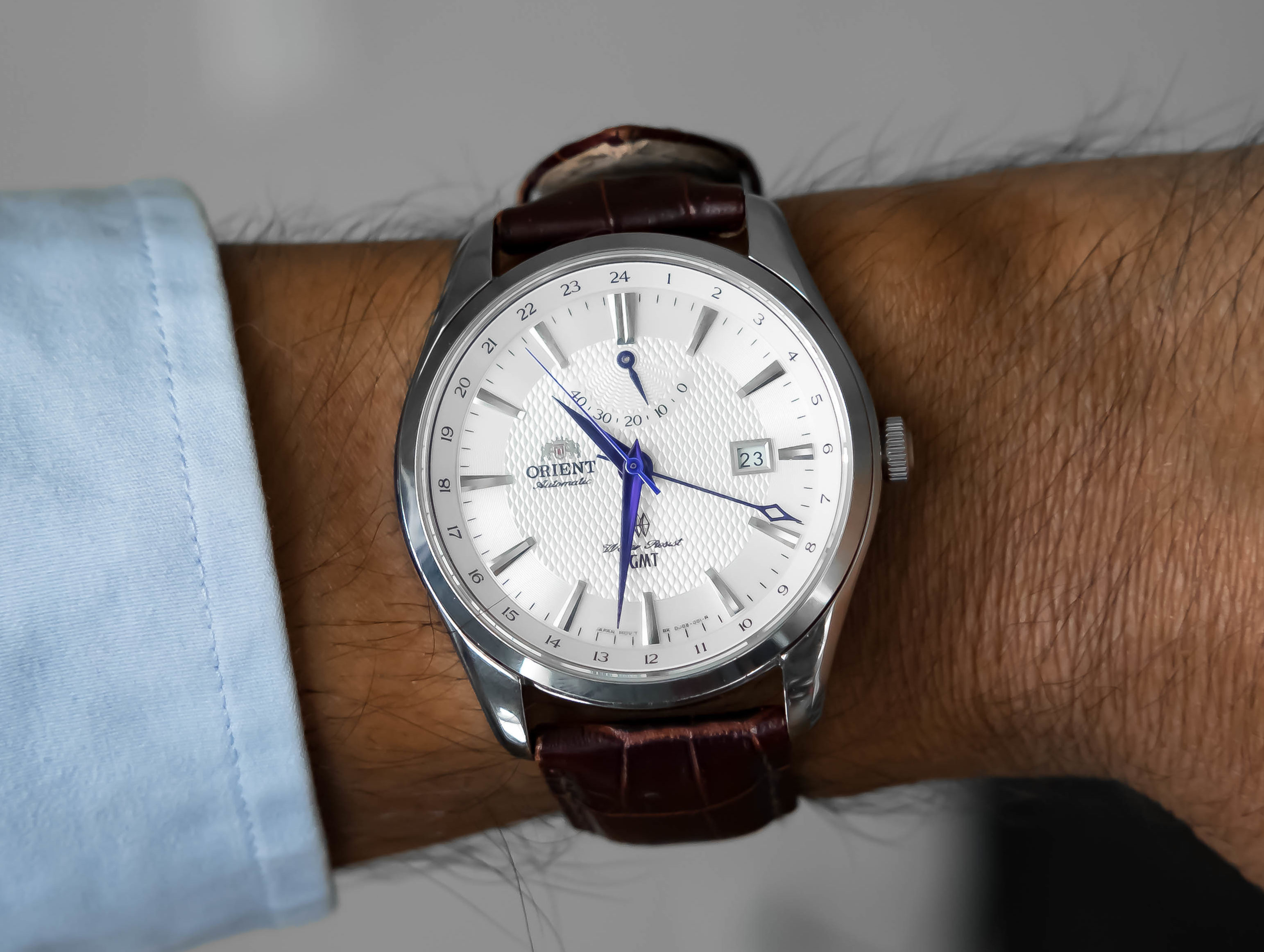
I’m a big fan of Orient, but I do worry that actually traveling with this watch and setting the time when landing some where would end up being a big pain since the 4th GMT hand is not independent from the main hour hand as other GMT watches are (https://www.orientwatchusa.com/set-gmt-dual-time-world-time-watch/). In other words, you land, change your local time and now your GMT hand has moved to some random time. Now you have to look up what time it is back home so you can reset the GMT hand.
Yea I can totally see that – you’d have to do some extra adjustments for sure when attempting to change the time. For me personally it’s not entirely a deal breaker, but I can totally understand how for someone it could be – esp if they travel a lot and have to change the time more than once a week.
Hi Kaz, I’m from the UK. How and where can I buy this (Orient Polaris GMT) watch? Is there any trusted online seller in the US who can post it to me in the UK. Thanks
100% agree. Kaz, love you, but you clearly don’t travel to distant time zones much. This functionality is absolutely a deal breaker for anyone who uses a GMT for international travel. It is a bit disappointing not to even discuss this issue. It is the biggest distinguishing factor for a GMT. Imagine having a chronograph that didn’t have a reset button, and instead you had to hand wind the chrono hand back to zero perfectly every time you used it. Would that be a deal breaker? Basically the same level of annoyance.
Hey, dude –
Super appreciate you leaving feedback. I’m actually going to revisit the movement section of this review because you and the other folks who’ve reached out to me are totally right. And this is also what I honestly love about TBWS – it’s two way learning. From my desk-diving, non time-zone traveling perspective, this thing is perfect. But obviously based off what you’ve explained here if someone were to rely on this as their “flying, timezone changing watch,” it’d be mad annoying. So my apologies if the review felt like it didn’t acknowledge something that was a setback of the inhouse Orient movement. At the time of me writing this I just didn’t have the proper GMT-specific experience to catch that detail. But rest assured that in addition to awesome comments from folks in the watchfam that I’ve conducted my own research and moving forward I’ll now have the proper understand of practical GMT-functionality in mind.
Thanks!
-Kaz
Didn’t mean to come off too harshly, very much appreciate everything you do. Agree on the two-way street thing for sure! Your comment made me remember that if you do use a GMT to track a distant time zone, rather than travel yourself, this kind of setup is way way better. I forget because I use mine when I fly.
So, to summarize, I guess the only rational conclusion is to make sure one has both in the collection, right?
Thanks again!
Hey, Rob –
Nah, man – not too harsh at all! I’m also super happy to have folks jump on the site and let me know what’s up. And the reality is that you were just helping me understand a perspective of GMT-ownership that I hadn’t been exposed to just yet. So you’re good, man.
Ha – exactly! The more GMTs the better anyway lol – I also want to be able to put some time with a quartz GMT piece down the road. I’ve only had hands on time with mechs. I think Alpina makes a cool quartz GMT I may try and source at some point…
-Kaz
One additional thought on the utility of this GMT implementation: In the past, when I’ve had a single timezone destination on my itinerary, I would preset the GMT hand “inversely” from my home zone so that, upon landing and changing to the local time, it should display properly.
This implementation is clearly set up for a single pair of timezones, which is not very versatile for someone who hits multiple timezones on a trip (say, SF to London, then Munich). A non-traveling utility is tracking the time, at a glance, of an overseas business partner, international division office, etc.
But I’m going to assume that a business person who engages in a lot of multi-destination international travel can probably afford a watch with a more sophisticated GMT complication.
I see what you did there, you now have a valid excuse to buy another watch! Lol.
Seiko makes some great kintetic quartz GMTs that are worth checking out too. They have the “travel” style movement and the kinetic thing is cool in my opinion.
Ive got a Seiko GMT mod by https://www.dragonshroud.com/. It’s a 7002 with a quartz GMT. Its got independent hands so good for travel, highly moddable and affordable. Mine looks a little 007ish with a mother of pearl face and is wicked.
I’ve also got the quartz citizen nighthawk with the most unique GMT display. Also independent hands and affordable
I prefer a quartz GMT as I don’t want to worry if the time I’m seeing is real or incorrect if it hasnt been worn. This means I don’t need to wear or wind it all the time.
I totally love your site. Thanks for the great informative reviews
Randal
I have this watch and can only praise it for it’s looks and accuracy.
It is more accurate than the Orient Star, Tudor, Oris, Chris Ward and Frederique Constant watches I have.
Living in the UK I have to import Orient watches but I think they are worth it.
I don’t cross any time zones in the UK so I need not have a GMT watch but this watch just looks superb.
Hi Pat, how and where can I buy this watch from the UK. Which website did you buy Orient Polaris GMT watch? Thanks
logo is for sapphire crystal . it is common mark on all Orients with sapphire. Orient Star do not have it on dial though.
Great review Kaz and good perspective from the GMT users. Ive been wanting an affordable GMT for a bit and this is good info (in my head its now either this Orient or Seiko flight master). The Orient doubles by checking dress watch status which I also need. Don’t mind the faux blued hands but kind of wish the GMT hand on the Orient was a different colour from the rest though? Red perhaps would have been too much?
I can definitely feel where you’re coming from, but having it on the wrist I don’t feel like the GMT hand loses at-a-glance legibility at all. the minute/hour hands are so much thicker and the skeletonized “spear” tip on the GMT really make it stand out without “standing out”, if that makes any sense. which is one of the reasons I bought it (which was a considerable expense at the time). with the possible exception of the Orient logo – which I’m not a huge fan of – the entire dial flows together just wonderfully. nothing feels ostentatious or unnecessary. basically, if you (or any other readers) are turned off by the blue GMT hand – don’t be. it’s extremely legible. if I could change one thing I’d add a spot of lume instead of skeletonizing the GMT. just one of those things that could help travelers.
regarding the strap – which I agree is crap, but not as bad as your review would imply (or maybe time has changed things?) – is that it comes on what we would usually call “backwards”. it actually makes it much easier to strap on, but having the pressure on the “wrong” side of the wrist is definitely different.
Will this watch for a 6 inch wrist? I’m not sure the wrist size for the person in the picture
My wrist size hovers around 6.5 / 6.75 inches.
Hope that’s helpful!
-Kaz
I have a 6.25″ wrist and the watch is a bit big for me. However, the lug to lug is about 48 mm so it wears well and the dropped lugs don’t overhang my wrist. This watch is at the absolute limit for what I’d wear however, I love the look so that’s why I wear it.
You can quick set the gmt hand without changing the hour and minute hands.. all you have to do is pull the crown out to the 1st position. Turning the crown to in one direction changes the date, the other direction moves the gmt hand in 1 hour increments.. it’s in the manual.. just sayin.
Ive just managed to source one and cant wait for it to arrive. I just cant get people who moan about the 10s of their lives they never get back due to having to reset a GMT hand! If thats their beef then maybe a GMT watch isnt for you and you can just check your iPhone, like the rest of the world lol
I’ve had this watch for a couple of years. I travel with it and have no problems with the GMT hand setting. If I’m gaining 8 hours when I land, I move the GMT hand back 8 hours with the first position and then set the local time ahead in the second position. Done.
At this price point, I’m not expecting a jumping hour hand. I also prefer that the date changes with the local time and not the GMT hand. When I tell people what I paid for this watch, they don’t believe me!
If you like the look, get one. There’s nothing wrong with the GMT function on this watch. It’s not ‘true’ GMT, it’s ‘caller’ GMT which is better for my purposes of tracking time of where I am calling, emailing, zooming, whatever.
Hello Kaz,
First of all thanks’ a lot for your interesting review.
It seems a beautiful watch… Do you please know where I can get a new Orient Polaris GMT? Does Orient company still sell this watch? Do you know any reliable web site where I can get it?
Thank you so much in advance,
Best Regards,
Riccardo
Hi, Riccardo:
At this time I do not believe Orient is still offering the Polaris GMT, which is a shame really. I think your best bet would be to check the forums and see if anyone would be selling theirs second hand.
Best,
-Kaz